Maverick & Me
Katherine Schwarzenegger
 Katherine Schwarzenegger (daughter of Arnold and Maria) is an ASPCA Ambassador and bestselling author. She has a new children's book, which will empower young readers to help dogs who find themselves in shelters and animal rescues.
Katherine Schwarzenegger (daughter of Arnold and Maria) is an ASPCA Ambassador and bestselling author. She has a new children's book, which will empower young readers to help dogs who find themselves in shelters and animal rescues.
The book, Maverick and Me, is inspired by her work with dog rescues and the life of her own rescue pup, Maverick. While fostering rescue dogs, Katherine cared for Maverick, a small puppy that had been found under a highway overpass. Maverick was only 2 weeks old when found and needed someone who could spend the time to care for him and feed him through a syringe. Katherine nursed young Maverick even when he became seriously ill. After developing a strong bond with him, Katherine decided to adopt the brave puppy that had stolen her heart. Maverick is now 3 years old.
Katherine is no stranger to animals. In the Schwarzenegger household they grew up with dogs, horses, pigs, ducks and rabbits. All the neighborhood kids wanted to go to the Schwarzenegger house, which was the most popular in the neighborhood, because they always had a pony or a pig in the house. Because of this Katherine says she had such a great childhood.
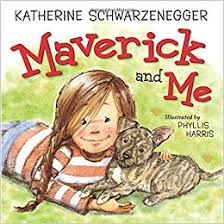 Katherine tells us that both her parents grew up on farms and they felt it was important for their children to grow up with animals as well. Children are taught responsibility by feeding and taking care of animals. To this day, the Schwarzeneggers have a house full of animals. Arnold has a miniature pony as well as many dogs and Maria has dogs as well. The other children have continued this tradition with their own pets.
Katherine tells us that both her parents grew up on farms and they felt it was important for their children to grow up with animals as well. Children are taught responsibility by feeding and taking care of animals. To this day, the Schwarzeneggers have a house full of animals. Arnold has a miniature pony as well as many dogs and Maria has dogs as well. The other children have continued this tradition with their own pets.
Katherine wrote her book because she felt it was important to talk to children about adopting or rescuing, especially when it comes to a time when they will get their first pet. Katherine says it was a huge deal for her when she got her first pet, but she didn't really know about dog rescues or the ability to adopt at that time. The reaction from children who see her dog think that it is so incredible that you can get a dog who has a story behind them. Also, a lot of kids come up to Maverick because of his brindle color and say, "That dog looks like a tiger! Where can I get a tiger dog?" She says it is so important to teach them while they are young about rescuing and adopting.
Visit Website
Why Is Recognizing And Treating FAS (Fear, Anxiety & Stress) So Important?
Dr. Lisa Radosta, Florida Veterinary Behavior Service
 Dr. Lisa Radosta, owner Florida Veterinary Behavior Service, explains what causes fear, anxiety, and stress in our pets? How does this fear, anxiety and stress affect them? Why is it so important that we address the fear, anxiety and stress in our pets? What is one simple thing we can do to reduce fear, anxiety and stress in our pets?
Dr. Lisa Radosta, owner Florida Veterinary Behavior Service, explains what causes fear, anxiety, and stress in our pets? How does this fear, anxiety and stress affect them? Why is it so important that we address the fear, anxiety and stress in our pets? What is one simple thing we can do to reduce fear, anxiety and stress in our pets?
Do you ever wonder what your new pet, be it a cat, dog, bunny, etc., thinks about when they go into a veterinary hospital for the first time? Most of them will be naive as to what is going to happen and will probably be pretty open to the experience. They may think the vet seems nice and decide to just let the experience happen. But once they get poked and prodded, even in the name of helping them, they may think the doctor is up to no good.
Unless there is no effort, or even if there is just a little effort but not enough to immediate that fear, which can grow and snowball very quickly, most of the pets (about 80%) are afraid of going back. They also want to leave immediately after the examination is done.
So how does this fear affect our pets? Think about how it feels when you are scared. When humans or animals are scared, there is a physiologic stress response, which is outside of anyone's control. It starts in the brain and the neurotransmitters in the brain control that entire body. It starts in a nanosecond and that entire cascade occurs in seconds. It feels like a tight chest, a stomach that is upset, tense muscles, panting and or a heart that is racing.
Your first response may be to just say get over it. But when it's physiologic, it's not a "get over it" moment. It's a moment where we have to do something external to help the pet get over it.
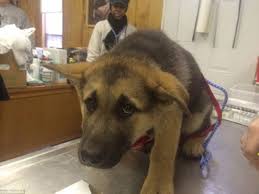 Over time, this stress can wear a pet down. Imagine if you worked at a job you hated and there was no way you could quit. It's outside of your control and you had to go every day. Think about how emotionally stressed you would be. Again, we go back to the neurochemical stress response, which snowballs into a chronic stress response. And yes, it beats an animal down. What Dr. Radosta sees, is that these animals have a shorter "fuse" over time, especially at the veterinarian's office and it takes less and less for them to act as if they are fighting for their life, to hide under a chair or to urinate or defecate on themselves.
Over time, this stress can wear a pet down. Imagine if you worked at a job you hated and there was no way you could quit. It's outside of your control and you had to go every day. Think about how emotionally stressed you would be. Again, we go back to the neurochemical stress response, which snowballs into a chronic stress response. And yes, it beats an animal down. What Dr. Radosta sees, is that these animals have a shorter "fuse" over time, especially at the veterinarian's office and it takes less and less for them to act as if they are fighting for their life, to hide under a chair or to urinate or defecate on themselves.
The Fear Free Movement is trying to make veterinary care more like pediatric dentistry or pediatric medicine. This has changed so much from when we were younger and many of us were manhandled and manipulated, threatened and abused. Now, these offices are geared towards children to make them comfortable and relaxed to where they actually enjoy going. This is what they are trying to do for our pets.
We want our pets to live happy lives, as much as we want to live happy lives. There are many things you can do to help your pet, but the most important thing you can do is to understand your pet's body language better. Our biggest fault as pet parents and as veterinarians is not reading the animal properly.
Dr. Radosta explains that there have been many times when she sat with an owner and told them that their dog's tail was tucked, which meant he was scared. The pet parents were surprised and didn't pick up on meaning of this. She states that these are great pet parents and people who truly care about their pets. They just have no clue what those fear signals are. If all pet parents could read their pet well, according to Dr. Radosta, they would be aware of these signals and awareness is always the first step when you have a problem.
But what can you do at home? Remember, if your home isn't fear free, that doesn't mean you're a bad pet parent. We all have places in our lives where we lack knowledge and this might be a place for a pet parent to grow.
 Chronic stress in a home setting has also been linked to other emotional disorders in pets, but also to suppression of the immune system and to some dermatological problems as well.
Chronic stress in a home setting has also been linked to other emotional disorders in pets, but also to suppression of the immune system and to some dermatological problems as well.
The number one thing we can do for our pets at home is enrichment, for cats especially! For example, Dr. Radosta is a runner and if she doesn't get to run, her family actually brings out her running shoes and pushes her out the door, because her attitude is poor. She actually needs this enrichment and cats and dogs need that as well. Every age, every breed every species can have an enriched life.
There are other things you can do as well for your pets. For cats, carriers can be left out around the house to become a natural part of the landscape, perhaps sitting out near inviting food or with the top off so that it becomes an intriguing box to investigate. This way, the carrier doesn't suddenly appear as a menacing object that's inevitably associated with a trip to the vet. For dogs, it may be things like basic training, daily walks and food puzzles to challenge their minds. For more tips on how to make your home fear free, please visit Fear Free Happy Homes.
Visit Website
Listen and Explore the Fear Free Expert Series
Coyotes Stalking our Neighborhoods - Dr. Debbie
 I just saw a scraggly coyote in front of my house this morning - the second coyote sighting in my neighborhood this week. I feared what could have happened if my 15 pound terrier was outdoors alone. Wildlife is beautiful, but when my little terrier, Boss, is in harm's way - my doggie momma protective instincts kick in. While not a threat to be exaggerated, the coyote nonetheless poses a risk to our pet's safety.
I just saw a scraggly coyote in front of my house this morning - the second coyote sighting in my neighborhood this week. I feared what could have happened if my 15 pound terrier was outdoors alone. Wildlife is beautiful, but when my little terrier, Boss, is in harm's way - my doggie momma protective instincts kick in. While not a threat to be exaggerated, the coyote nonetheless poses a risk to our pet's safety.
Coyotes are increasingly becoming a concern in urban areas - some are displaced by the urban sprawl that consumes their potential habitat. But other coyotes become urbanized savvy to living, feeding and thriving within city environments. Coyotes are born opportunists and dine on what they find available. They eat small animals like rabbits and rodents, but also consume ample vegetable matter with up to 40-percent of their diet consisting of seeds, grasses, fruits and flowers.
The most serious coyote concern for pets is injury and predation. As a veterinarian, I can recall many a client whose pet was brought in injured by unknown wildlife or whose cat just one day reportedly just vanished. While many might believe their cat was stolen, in reality these cats most likely fell victim to coyote predation. Likewise, small to medium sized dogs can be injured or lost to the same fate as their feline counterparts.
Steps to Keep Your Pet Safe
Whether you have pets or not, it's important not to feed coyotes. Intentional feeding of coyotes makes them dependent on humans and less fearful which increases the chance of an unwanted, dangerous interaction with people or pets. Just leaving unsecured garbage is invitation enough for these opportunists. Secure all garbage in closing containers and avoid leaving bagged garbage at the curb overnight. Pick up uneaten pet food as soon as your pet has finished eating.
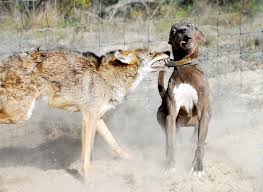 Pet owners should take precautions to keep their household pets protected as well. Keep cats indoors and maintain all pets on leash control when outdoors. Ensure your dogs and cats are up to date on their rabies vaccines. Even indoor cats that do not venture outdoors should be current on this vaccine for both pet and human safety.
Pet owners should take precautions to keep their household pets protected as well. Keep cats indoors and maintain all pets on leash control when outdoors. Ensure your dogs and cats are up to date on their rabies vaccines. Even indoor cats that do not venture outdoors should be current on this vaccine for both pet and human safety.
Besides rabies, keep your pets current on other vaccinations, deworming and preventatives as recommended by your veterinarian. Coyotes are known to harbor carry skin mites, canine distemper virus, canine parvovirus, adenovirus and heartworm disease. So even if your dog never leaves your yard, there is potential for infectious disease crossover between wildlife and your pet.
These wild canids are masters at adapting to their changing world, and it's unrealistic they are going away on their own. As humans we are the ones that need to change to make urban areas less appealing, removing easy feeding sites, and by raising awareness to the potential crossover between wildlife and pets.
Featured veterinarian known as "Dr. Debbie" on national pet radio program, Animal Radio. Ebook author of "Yorkshire Terriers: How to Be Your Dog's Best Friend"; "Pugs: How to Be Your Dog's Best Friend"; "Mini Schnauzers: How to Be Your Dog's Best Friend"; and "Shih Tzu: How to Be Your Dog's Best Friend."
Visit Website
10 Ways to Prepare Now For A Pet Emergency
Robert Semrow, Listomania
 I want all of you to safely stop what you are doing and think for a moment, "If an emergency situation happened right now…what will I wish I had done for the wellbeing of pets."
I want all of you to safely stop what you are doing and think for a moment, "If an emergency situation happened right now…what will I wish I had done for the wellbeing of pets."
We all feel like we have things covered and that we have what we need if an emergency were to occur, but the sad reality, and we've all seen the news reports, is that things can and do happen when we are least prepared. So, we here at Animal Radio are hoping that you'll take 15 minutes this weekend and reassess what you have for your pets, what you need for your pets and what would you do with your pets during an emergency. All three of those will likely have different answers and issues to consider.
To begin with, let's start with the legal needs, meaning important paperwork. Do you have a copy of their vaccination and medical records, proof of ownership, maybe your dog license paperwork and a few photos? This serves the dual purpose of not only reuniting with your dog if you are separated for any reason, but also for shelters that allow pets. Many of them will ask for this type of information. Have it all with you to minimize the stress and chaos.
 Next up are the living essentials. Do you have enough food and water in the case that you are on your own for a while before help can establish a return to normalcy? Remember to periodically rotate these items and check them. All too often, moisture and other environmental considerations can taint foods and treats. Additionally, if you had to be mobile, could you take some or all of it with you?
Next up are the living essentials. Do you have enough food and water in the case that you are on your own for a while before help can establish a return to normalcy? Remember to periodically rotate these items and check them. All too often, moisture and other environmental considerations can taint foods and treats. Additionally, if you had to be mobile, could you take some or all of it with you?
This applies to Medications as well. Do you have enough for at least a week so that if you had to flee or shelter in place, your beloved pet would have the medications it needs?
One of the best tips I can give is to pack these materials in a quick 'grab and go' manner. It might be in a backpack, plastic bin or other easy to travel container. Inside this grab and go should also be a few treats, a favorite toy or two, an extra leash and poop bags, and I love collapsible travel food and water bowls for this purpose.
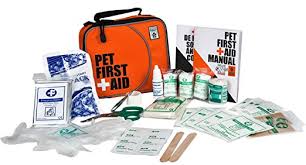 Other items to include a pet first aid kit, wet wipes and a blanket or towel which serves multiple purposes.
Other items to include a pet first aid kit, wet wipes and a blanket or towel which serves multiple purposes.
All of these things should be ready to go mobile if need be. And long before the need arises, you should also check with your local authorities to see what the plans for pets are in emergency situations. Some shelters allow pets, others don't, some have specific plans for pets of all types and how they will be housed and cared for in an emergency. Knowing this ahead of time will help you plan and give you focus and reassurance during that critical time.
The more you do today, the better of you and your pets will be. Share your pet emergency preparedness planning tips on our Animal Radio Facebook Page.
Visit Website
Animal Radio News - Lori Brooks
 Vets and Pets Parents See The World Differently
Vets and Pets Parents See The World Differently
The world of pets has expanded in every direction over the past few years and now researchers are studying the world of pet parents and how you make decisions about your pet's care. One of the things they found is that veterinarians and pet owners see the world differently. For example, when it comes to preventive care, pet parents believe it involves their pet's emotional well-being, exercise, nutrition, play and veterinary care. But veterinarians see preventive care as spaying and neutering, providing vaccines and establishing a parasite control program. About vet office visits: for veterinarians, the visit is to evaluate and determine the best course of action. For the pet owner, it's to get expert advice to include in their decision-making process. And, when it comes to Dr. Google, most vets hate it when you say, "I searched the Internet..." This new research shows that most veterinarians think the Internet is, "A dangerous, misinformed place for the pet parent to take a chance on their pet's health." But, for pet owners, it's an on-demand source of huge amounts of information they can use as they make decisions concerning their fur baby.
 Buy A Salad - Get a Pet!
Buy A Salad - Get a Pet!
A southern California woman has a new pet frog after finding the distressed amphibian in a large container of lettuce mix she bought at a local Target. She had already made her salad, poured on the dressing and was just about halfway through eating it when she saw something in her bowl that was moving. Being a strict vegetarian, the woman says she was so traumatized that she vomited after finding the frog in her salad and that she has no desire to eat salad ever again. However, she quickly scooped up the little frog and rinsed off the dressing, but she noticed the frog was barely alive so she did chest compressions on it (frog CPR) and it survived. His name is now Lucky.
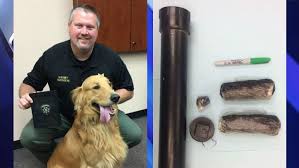 Dog Digs Up $85,000 Worth of Drugs
Dog Digs Up $85,000 Worth of Drugs
A dog in Oregon has been honored by the local sheriff for digging up $85,000 worth of black tar heroin in his family's backyard. The 18-month-old golden retriever dug up what his family first thought was a time capsule so they decided to video themselves opening it. Then they saw the contents, 15 ounces of heroin! To show their appreciation, the sheriff named the pup an honorary narcotics dog for life.
Fleas Test Positive for Plague
If you live in Arizona you should know that fleas in two counties (Navajo and Coconino) in the state have tested positive for the plague and health officials are urging residents to take precautions. The plague can be present in fleas, rodents and rabbits as well as the predators that feed on these animals. The plague can also be transmitted to humans and other animals through the bite of an infected flea or by direct contact with an infected animal. You can limit your risk of exposure by avoiding rodent burrows, keeping dogs on a leash and don't handle sick or dead animals. Pet parents are advised to de-flea pets routinely, use insect repellents and to be aware that cats are highly susceptible to the plague.
 To Kiss Your Dog or Not To Kiss Your Dog
To Kiss Your Dog or Not To Kiss Your Dog
A USA Today article cited lots of research and experts both for and against dogs licking humans on the lips. For example, there are more than 700 different types of bacteria in a dog's mouth, and that's just normal bacterium, what is expected to be found in a healthy dog's mouth. Two Atlanta vets say there are two kinds of cases to be concerned about. One, if a dog licks someone who has a weak immune system (like those with cancer) and two, if the dog has a medical condition that could spread, such as periodontal disease or intestinal parasites, which increases the risk for cross-infection. Most experts say if you were aware of what your dog puts in its mouth, you probably wouldn't even want Fido to kiss you. Consider the close proximity of their mouths to other dog's butts; things they step on outside then lick their feet and then those who eat poop. The list goes on and on. But use your common sense and your own judgment when it comes to kissing dogs, because on the whole, there really isn't enough data to show whether or not dog saliva is healthy or unhealthy for humans. One doctor researching this subject says she's heard many personal stories from people on both sides of the spectrum, including one who claimed their dog's kisses healed them from skin cancer and another who believes dog saliva caused a family member's death.
Millennials Make Pets' Lives Better
Millennials are behind the idea of pets as family members and making animals' lives better. A new survey shows that for Millennials (those between the ages of 18 and 36) pets really are like their children with one third of them, who purchased their first home, doing so because it had a yard and was a better space for their dog. Only 25-percent of Millennials bought their first home because they got married and 19-percent because they had children.
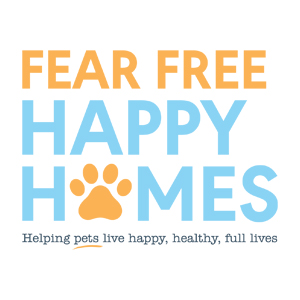
NEWS UPDATE brought to you by Fear Free. "Take the 'pet' out of 'petrified'" and get pets back for veterinary visits by promoting considerate approach and gentle control techniques used in calming environments.
 Listen to the entire Podcast of this show (#927)
Listen to the entire Podcast of this show (#927)



 Katherine Schwarzenegger (daughter of Arnold and Maria) is an ASPCA Ambassador and bestselling author. She has a new children's book, which will empower young readers to help dogs who find themselves in shelters and animal rescues.
Katherine Schwarzenegger (daughter of Arnold and Maria) is an ASPCA Ambassador and bestselling author. She has a new children's book, which will empower young readers to help dogs who find themselves in shelters and animal rescues.
 Katherine tells us that both her parents grew up on farms and they felt it was important for their children to grow up with animals as well. Children are taught responsibility by feeding and taking care of animals. To this day, the Schwarzeneggers have a house full of animals. Arnold has a miniature pony as well as many dogs and Maria has dogs as well. The other children have continued this tradition with their own pets.
Katherine tells us that both her parents grew up on farms and they felt it was important for their children to grow up with animals as well. Children are taught responsibility by feeding and taking care of animals. To this day, the Schwarzeneggers have a house full of animals. Arnold has a miniature pony as well as many dogs and Maria has dogs as well. The other children have continued this tradition with their own pets. Dr. Lisa Radosta, owner Florida Veterinary Behavior Service, explains what causes fear, anxiety, and stress in our pets? How does this fear, anxiety and stress affect them? Why is it so important that we address the fear, anxiety and stress in our pets? What is one simple thing we can do to reduce fear, anxiety and stress in our pets?
Dr. Lisa Radosta, owner Florida Veterinary Behavior Service, explains what causes fear, anxiety, and stress in our pets? How does this fear, anxiety and stress affect them? Why is it so important that we address the fear, anxiety and stress in our pets? What is one simple thing we can do to reduce fear, anxiety and stress in our pets?
 Over time, this stress can wear a pet down. Imagine if you worked at a job you hated and there was no way you could quit. It's outside of your control and you had to go every day. Think about how emotionally stressed you would be. Again, we go back to the neurochemical stress response, which snowballs into a chronic stress response. And yes, it beats an animal down. What Dr. Radosta sees, is that these animals have a shorter "fuse" over time, especially at the veterinarian's office and it takes less and less for them to act as if they are fighting for their life, to hide under a chair or to urinate or defecate on themselves.
Over time, this stress can wear a pet down. Imagine if you worked at a job you hated and there was no way you could quit. It's outside of your control and you had to go every day. Think about how emotionally stressed you would be. Again, we go back to the neurochemical stress response, which snowballs into a chronic stress response. And yes, it beats an animal down. What Dr. Radosta sees, is that these animals have a shorter "fuse" over time, especially at the veterinarian's office and it takes less and less for them to act as if they are fighting for their life, to hide under a chair or to urinate or defecate on themselves. Chronic stress in a home setting has also been linked to other emotional disorders in pets, but also to suppression of the immune system and to some dermatological problems as well.
Chronic stress in a home setting has also been linked to other emotional disorders in pets, but also to suppression of the immune system and to some dermatological problems as well.  I just saw a scraggly coyote in front of my house this morning - the second coyote sighting in my neighborhood this week. I feared what could have happened if my 15 pound terrier was outdoors alone. Wildlife is beautiful, but when my little terrier, Boss, is in harm's way - my doggie momma protective instincts kick in. While not a threat to be exaggerated, the coyote nonetheless poses a risk to our pet's safety.
I just saw a scraggly coyote in front of my house this morning - the second coyote sighting in my neighborhood this week. I feared what could have happened if my 15 pound terrier was outdoors alone. Wildlife is beautiful, but when my little terrier, Boss, is in harm's way - my doggie momma protective instincts kick in. While not a threat to be exaggerated, the coyote nonetheless poses a risk to our pet's safety. Pet owners should take precautions to keep their household pets protected as well. Keep cats indoors and maintain all pets on leash control when outdoors. Ensure your dogs and cats are up to date on their rabies vaccines. Even indoor cats that do not venture outdoors should be current on this vaccine for both pet and human safety.
Pet owners should take precautions to keep their household pets protected as well. Keep cats indoors and maintain all pets on leash control when outdoors. Ensure your dogs and cats are up to date on their rabies vaccines. Even indoor cats that do not venture outdoors should be current on this vaccine for both pet and human safety. I want all of you to safely stop what you are doing and think for a moment, "If an emergency situation happened right now…what will I wish I had done for the wellbeing of pets."
I want all of you to safely stop what you are doing and think for a moment, "If an emergency situation happened right now…what will I wish I had done for the wellbeing of pets."  Next up are the living essentials. Do you have enough food and water in the case that you are on your own for a while before help can establish a return to normalcy? Remember to periodically rotate these items and check them. All too often, moisture and other environmental considerations can taint foods and treats. Additionally, if you had to be mobile, could you take some or all of it with you?
Next up are the living essentials. Do you have enough food and water in the case that you are on your own for a while before help can establish a return to normalcy? Remember to periodically rotate these items and check them. All too often, moisture and other environmental considerations can taint foods and treats. Additionally, if you had to be mobile, could you take some or all of it with you? Vets and Pets Parents See The World Differently
Vets and Pets Parents See The World Differently
 Buy A Salad - Get a Pet!
Buy A Salad - Get a Pet!
